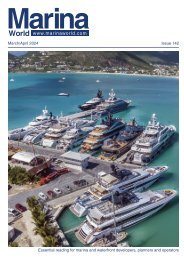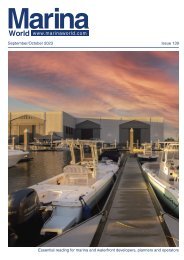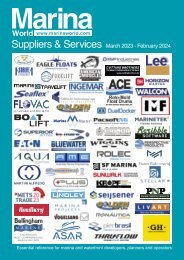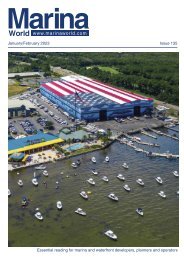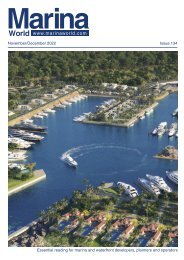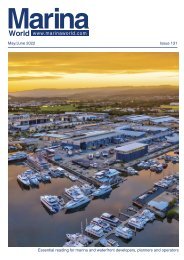2024 January/February Marina World
The magazine for the marina industry
The magazine for the marina industry
Create successful ePaper yourself
Turn your PDF publications into a flip-book with our unique Google optimized e-Paper software.
ENVIRONMENTAL PRODUCTS & PROJECTS<br />
Whitepaper illuminates key<br />
role of bi-directional charging<br />
UK-based Aqua superPower has released an important whitepaper shedding<br />
light on the immense potential of Vessel-to-Everything (V2X) technology for<br />
the maritime industry. The landmark report rounds off the Virtual Bunkering<br />
of Electric Vessels (VBEV) project, which was funded by the UK Government<br />
to assess the financial, technical and operational feasibility of bi-directional<br />
charging infrastructure in the maritime sector.<br />
V2X is the overarching term for using<br />
bi-directional charging technology to<br />
transfer the energy stored by electric<br />
vessel batteries to the grid, buildings or<br />
load. With a sharp focus on the value<br />
of V2X technology for electric vessels,<br />
the VBEV project seeks to drive the<br />
sector’s decarbonisation and foster<br />
the development of a robust marine<br />
V2X ecosystem, enabling widespread<br />
adoption.<br />
Battery electric vessels have been<br />
identified as a cornerstone in the UK<br />
Government’s Clean Maritime Plan,<br />
particularly for short to medium range<br />
vessels like ferries, workboats and<br />
recreational boats. Furthermore, these<br />
batteries can also be seamlessly<br />
integrated with alternative fuels to<br />
create hybrid systems for vessels with<br />
longer range requirements.<br />
Upgrades at marinas, harbours<br />
and ports are anticipated to include<br />
charging infrastructure and shore<br />
power, dramatically increasing power<br />
demand and grid capacity, and<br />
reshaping dynamic between the energy<br />
and maritime sectors. As the adoption<br />
of battery electric vessels surges,<br />
substantial investments in enabling<br />
infrastructure at both system and site<br />
levels are indispensable.<br />
The paper, titled ‘The Opportunity for<br />
Bi-directional Charging in the Maritime<br />
Sector’, offers crucial insights into the<br />
cross-sector maritime V2X possibilities,<br />
including:<br />
• Enhancing energy flexibility and<br />
energy arbitrage services to support the<br />
power grid, thus promoting renewable<br />
energy generation, grid resilience and<br />
energy security.<br />
• Seamlessly integrating battery<br />
electric vessels into marina energy<br />
management, optimising onsite<br />
renewables, managing grid constraints<br />
and reducing energy costs.<br />
• Revolutionising the financial model<br />
for electric vessels by generating<br />
consistent revenue from V2X services,<br />
ultimately reducing the lifetime costs of<br />
vessel ownership.<br />
• Capitalising on the projected<br />
growth of battery electric vehicles,<br />
advancements in V2X technologies,<br />
escalating demand for renewables<br />
and the maturation of energy markets<br />
to drive the maritime sector towards<br />
net-zero emissions and economic<br />
opportunities.<br />
The paper aims to underscore<br />
the pivotal role V2X can play in the<br />
maritime sector and the wealth of<br />
opportunities it presents. It also outlines<br />
the key steps necessary to make<br />
marine V2X a reality, emphasising<br />
the critical need for universal<br />
communication standards among<br />
OEMs, utilities and charging companies<br />
to accelerate adoption.<br />
In conjunction with the paper, Cenex<br />
(UK Centre of Excellence for Low<br />
Carbon and Fuel Cell technologies) has<br />
also published a report titled ‘Vessel-to-<br />
Grid: An Analysis of Revenue Streams<br />
and Vessel Archetypes for Bi-Directional<br />
Charging of Electric Vessels.’ As part of<br />
the VBEV project, this report zeros in<br />
on the value of V2G for electric vessels,<br />
providing a comprehensive perspective<br />
on the immense potential of V2X<br />
technology in the maritime sector.<br />
“Aqua superPower is proud to<br />
lead the exploration of the future of<br />
maritime technology,” notes Adam<br />
Marshall, chief technology officer. “This<br />
whitepaper illuminates the potential of<br />
technology as a transformative force in<br />
the maritime sector. It underscores how<br />
bi-directional charging infrastructure<br />
can empower electric vessels as not<br />
only consumers, but as contributors<br />
to the grid, enhancing sustainability<br />
goals, reducing operational costs<br />
and catalysing an industry-wide shift<br />
towards clean energy solutions.”<br />
Aqua superPower CEO, Alex<br />
Bamberg, explains that V2X is not<br />
only a relatively novel concept in the<br />
maritime sector but is also in its infancy<br />
in the automotive industry, where it is in<br />
early stages of commercialisation with<br />
significant research and development<br />
projects ongoing. “The VBEV project<br />
sets the stage for a groundbreaking<br />
UK demonstrator of bi-directional<br />
boat charging, poised to unlock the<br />
substantial opportunities and benefits<br />
that this transformative technology<br />
offers to the maritime sector. We are<br />
proud to play a leading role in making<br />
V2X a reality for the benefit of all<br />
stakeholders,” he says.<br />
www.marinaworld.com – <strong>January</strong>/<strong>February</strong> <strong>2024</strong><br />
37




